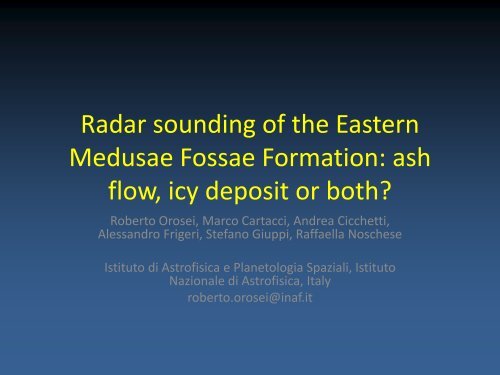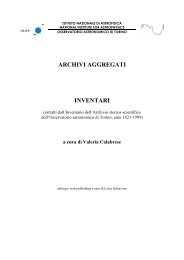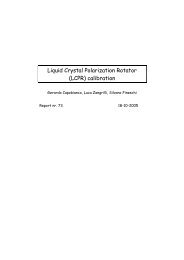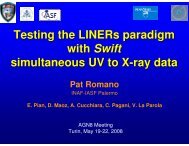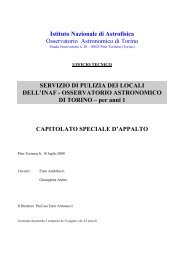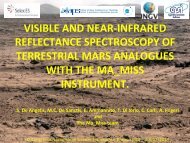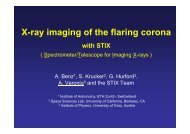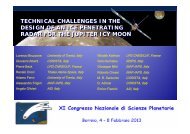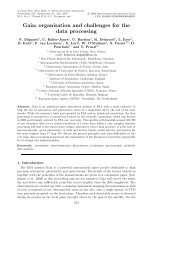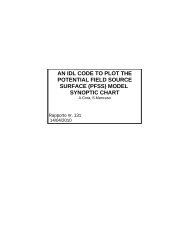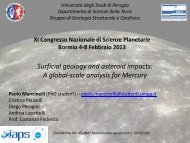Radar sounding of the Eastern Medusae Fossae Formation ... - Inaf
Radar sounding of the Eastern Medusae Fossae Formation ... - Inaf
Radar sounding of the Eastern Medusae Fossae Formation ... - Inaf
- No tags were found...
You also want an ePaper? Increase the reach of your titles
YUMPU automatically turns print PDFs into web optimized ePapers that Google loves.
• Launched on June 2,2003.• ESA's first planetarymission.• Carries sevenexperiments, including<strong>the</strong> Italian radarMARSIS.• Will remain operationaluntil 2014.Mars Express
MARSIS• Mars Advanced <strong>Radar</strong> for Subsurfaceand Ionosphere Sounding (MARSIS)radar sounder is <strong>the</strong> first since Apollo17.• It transmits and receives through a 40m dipole, and it also receives througha 7 m monopole.• It operates at frequencies <strong>of</strong> 1.8, 3, 4and 5 MHz with a bandwidth <strong>of</strong> 1MHz.• The main scientific goal is to detect<strong>the</strong> presence <strong>of</strong> solid or liquid waterin <strong>the</strong> subsurface <strong>of</strong> Mars.
Mars Reconnaissance Orbiter• Launched on August 12,2005.• NASA mission with highresolution sensors, tosearch for traces <strong>of</strong>water on <strong>the</strong> surface <strong>of</strong><strong>the</strong> planet.• It has now beenextended until 2013.
SHARAD• Shallow <strong>Radar</strong> (SHARAD) is a radarsounder designed before MARSISwas launched.• It transmits and receives through a9 m dipole.• It operates at a frequency <strong>of</strong> 20MHz with a bandwidth <strong>of</strong> 10 MHz.• The main scientific goal is <strong>the</strong>detection <strong>of</strong> dielectricdiscontinuities in <strong>the</strong> subsurface <strong>of</strong>Mars, and <strong>the</strong> interpretation <strong>of</strong><strong>the</strong>se discontinuities in terms <strong>of</strong>presence <strong>of</strong> ice, water, rock orregolith.
MARSIS and SHARAD• The Italian radar SHARAD isintended to be complementaryto MARSIS, obtaining highresolution sacrificingpenetration.• MARSIS was designed to map <strong>the</strong>global distribution <strong>of</strong> ice andwater in <strong>the</strong> subsoil.• SHARAD was born from <strong>the</strong>results <strong>of</strong> MGS on <strong>the</strong> presence<strong>of</strong> water near <strong>the</strong> surface inrecent times.
MARSIS vs. SHARAD
<strong>Radar</strong> Sounding <strong>of</strong> <strong>the</strong> <strong>Medusae</strong> <strong>Fossae</strong><strong>Formation</strong> Mars: Equatorial Ice or Dry, Low-Density Deposits?Watters et al. 2007
Shallow radar (SHARAD) <strong>sounding</strong> observations<strong>of</strong> <strong>the</strong> <strong>Medusae</strong> <strong>Fossae</strong> <strong>Formation</strong>, MarsCarter et al. 2009
Between Gordii Dorsum and Amazonis Mensa: MARSIS
Between Gordii Dorsum and AmazonisMensa: SHARAD (1)
Between Gordii Dorsum and AmazonisMensa: SHARAD (2)
Retrieving <strong>the</strong> dielectric properties <strong>of</strong>• Method taken fromPorcello et al. (1974)• The antenna cannot becalibrated• Ratio between Ps andPss is used• Simultaneousobservations at tw<strong>of</strong>requencies allowretrieval <strong>of</strong> loss tangent<strong>the</strong> subsurface
A typical echo <strong>of</strong> MARSIS over <strong>the</strong> area
Results• Thickness– First layer: 750 / m– Second layer: 700 / m• Loss tangent– First layer: 0.01– Second layer: 0.003
Summary• Layering in <strong>the</strong> plains between Amazonis Mensa andGordii Dorsum has been observed by MARSIS and, to alesser extent, by SHARAD• This is <strong>the</strong> only place outside <strong>the</strong> PLD where MARSISdetects more than one subsurface discontinuity.• Although MARSIS coverage is still sparse, it seems that<strong>the</strong> two layers are ei<strong>the</strong>r present or absent toge<strong>the</strong>r.• Dielectric properties in <strong>the</strong> upper layer are compatiblewith those <strong>of</strong> dry rock• Dielectric properties in <strong>the</strong> second layer are compatiblewith those <strong>of</strong> very porous rock or regolith, or dirty ice.


